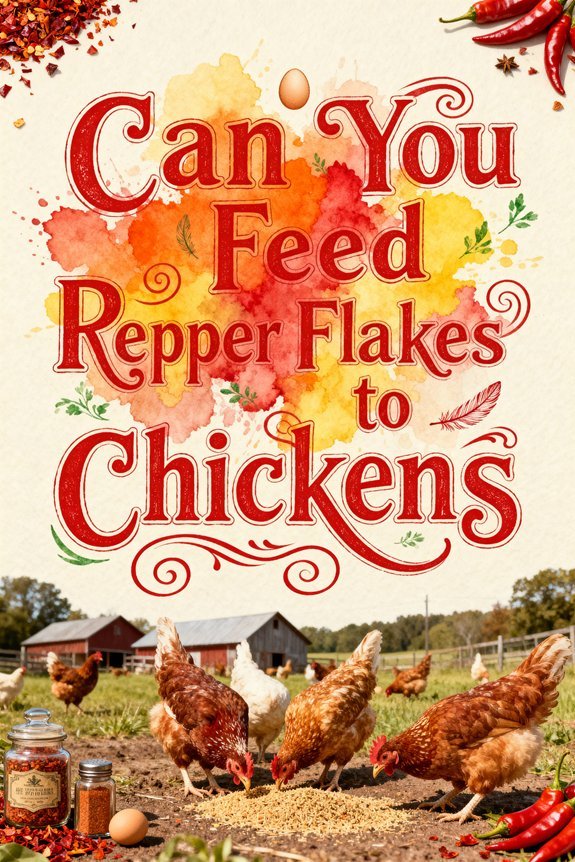Can You Feed Red Pepper Flakes to Chickens?
Yes, you can safely feed red pepper flakes to your chickens at 0.5% to 1% of their daily feed intake. The capsaicin in red peppers provides immune support, helps control parasites, and improves nutrient absorption without toxicity risks. You’ll typically see benefits like increased egg weights from 66.1g to 71.7g and enhanced yolk coloration. Start with small amounts mixed thoroughly into feed, as proper dosage and administration are key to maximizing these natural advantages.
The Safety of Red Pepper Flakes in Chicken Feed
Red pepper flakes present a safe feed supplement for chickens when used appropriately, with research supporting inclusion rates of 0.5% to 1% of total feed composition. Supplementation research confirms that capsaicin, the active compound in red peppers, poses no toxicity risk to poultry at recommended levels of 5-10 grams per kilogram of feed.
You’ll find that moderate red pepper supplementation doesn’t negatively impact your chickens’ feed consumption or conversion ratios. While you should handle the flakes carefully to avoid skin and eye irritation, your birds can safely process and benefit from the capsaicin effects. The antimicrobial and antiparasitic properties may even enhance gut health and nutrient absorption in your flock, particularly during less productive seasons. When combined with oregano, red pepper flakes can provide valuable antibacterial and antifungal properties to your chicken feed. Most healthy chickens have four standard toes that help them maintain balance while feeding, though some rare breeds possess a fifth toe.
Health Benefits for Your Flock
While many poultry supplements offer limited benefits, scientific research confirms that red pepper flakes provide multiple significant health advantages for your flock. The capsaicin content strengthens your chickens’ immune support by reducing infection risks and enhancing disease resistance. When you incorporate red pepper flakes into your feeding strategies, you’ll boost your birds’ antioxidant intake through beneficial carotenoids and vitamins A and C.
These compounds don’t just protect cellular health – they also help control internal parasites and limit worm infestations naturally. Using 0.5 to 1 gram of hot pepper flakes per chicken ensures optimal health benefits without overfeeding. You’ll see improved feed efficiency as capsaicin enhances nutrient absorption and metabolic function. Additionally, red pepper flakes deter rodents from contaminating feed while promoting natural foraging behaviors in your flock, contributing to both physical health and environmental cleanliness. The natural antibiotic effects of red pepper flakes can help maintain flock health while reducing reliance on artificial medications.
Impact on Egg Production and Quality
Research demonstrates that incorporating red pepper flakes into chicken feed can greatly influence both egg production metrics and quality markers. Studies show that supplementation increases egg weight from approximately 66.1g to 69.7-71.7g, while laying performance remains stable or slightly improves from 84.4% to 87.4-88.9%. Some farmers reduce red pepper supplements during summer months to maintain optimal dietary balance.
You’ll notice enhanced egg yolk coloration due to the carotenoids present in red pepper flakes, potentially increasing your eggs’ market value. While the supplement won’t considerably boost laying frequency, it won’t negatively impact production rates either. The feed conversion ratio and eggshell quality remain unaffected when red pepper is included up to 0.8% of the diet. For ideal results, consider using superfine red pepper powder, which shows marginally better effects on egg weight and laying performance compared to standard processing methods.
Recommended Dosage and Feeding Guidelines
Following established safety guidelines, the ideal dosage of red pepper flakes in chicken feed ranges from 0.5% to 1% of total daily feed volume. For practical measurement, use 0.5 to 1 teaspoon per cup of feed, or roughly 1 cup per 25 pounds of feed for larger flocks.
Since chickens lack the receptors for spiciness, they can safely consume red pepper flakes without discomfort. Effective feeding strategies include gradual introduction to build tolerance and prevent digestive upset. You’ll want to blend the flakes thoroughly into pellets or mix with seeds and dried herbs for consistent intake. When handling red pepper flakes, wear gloves to avoid skin irritation. For enhanced benefits, combine with dried oregano to leverage antimicrobial properties. You can administer the supplement seasonally, particularly during winter months when egg production typically decreases, to target parasites and support gut health.
Nutritional Value and Digestive Effects
Adding red pepper flakes to chicken feed delivers substantial nutritional benefits through its rich profile of bioactive compounds. The flakes provide essential vitamins C, B6, and folate that support immune function and protein absorption. Capsaicin, the active compound in red pepper, acts as a powerful antioxidant enhancing growth and stress resistance. Birds consistently fed red pepper flakes produce heavier eggs regularly.
You’ll notice improved digestion efficiency when supplementing with red pepper flakes, as they boost pancreatic and intestinal enzyme activity while enhancing bile acid secretion. The antimicrobial properties help combat parasites and bacterial infections in the gut, leading to better nutrient absorption. When combined with other herbs like oregano, red pepper’s antibacterial effects are amplified, promoting peak digestive health. The result is enhanced feed conversion and nutrient utilization in your flock.
Common Risks and Safety Precautions
Five key risks require careful consideration when feeding red pepper flakes to chickens. First, overfeeding can cause mild irritation and reduced feed intake, making proper dosage essential for risk management. Second, airborne pepper particles may trigger respiratory issues, especially in enclosed coops. Third, despite chickens’ lack of capsaicin receptors, individual birds might show sensitivity or allergic reactions. Fourth, excessive capsaicin could disrupt gut microbiota balance, potentially affecting nutrient absorption. Fifth, improper storage and administration methods may lead to quality deterioration or selective overconsumption.
To guarantee safety, introduce flakes gradually while monitoring health indicators. Mix thoroughly with feed, avoid use with young chicks, store in sealed containers, and watch for adverse reactions like lethargy or appetite changes. Discontinue use if problems arise. Some Mennonite farmers have traditionally added pepper to water to encourage higher water consumption in their flocks.
Best Practices for Mixing and Storage
To guarantee ideal effectiveness when incorporating red pepper flakes into chicken feed, proper mixing ratios and storage methods are essential. Use approximately one teaspoon of flakes per 5 pounds of feed, and employ dry mixing techniques to ensure even distribution throughout the feed. You’ll want to wear gloves during the process to prevent skin irritation. This natural addition helps combat internal parasites in your flock while avoiding harsh chemical treatments.
For peak storage solutions, keep your red pepper flakes in an airtight, opaque container in a cool, dry location away from direct sunlight. Prepare mixed feed in small batches to maintain the flakes’ potency. When combining with other supplements, mix the flakes with dried herbs like oregano for enhanced antimicrobial benefits. Don’t mix with wet ingredients or calcium supplements, as this can lead to clumping and nutrient imbalances.





